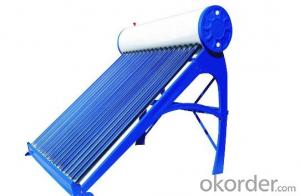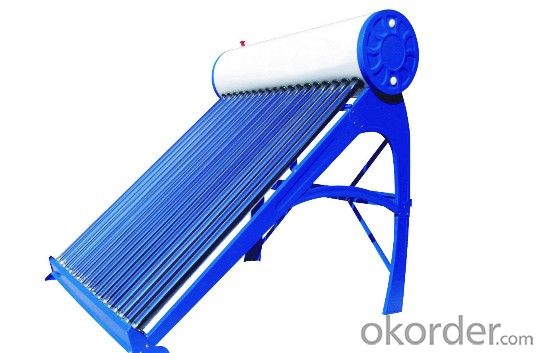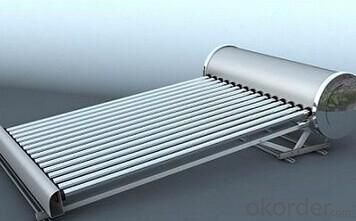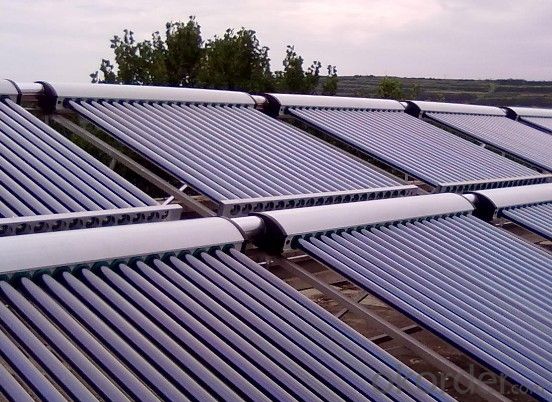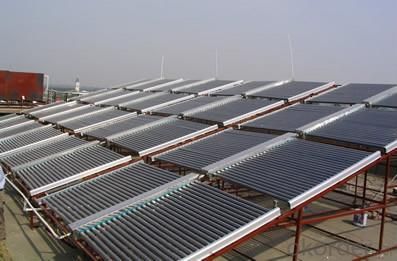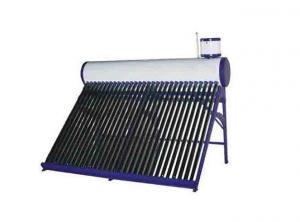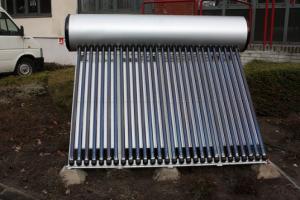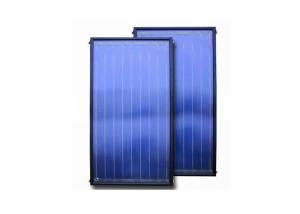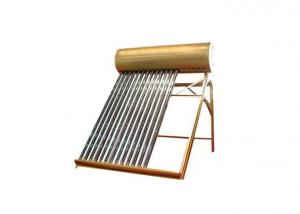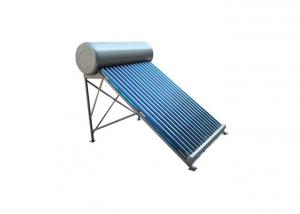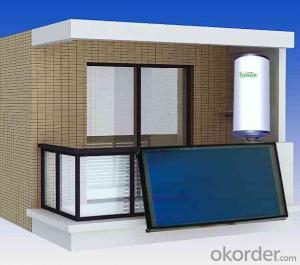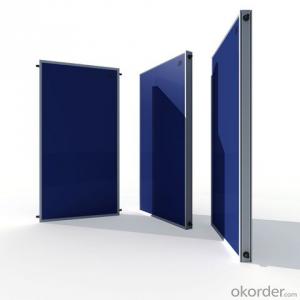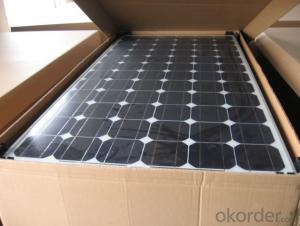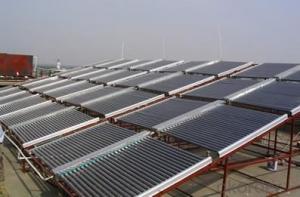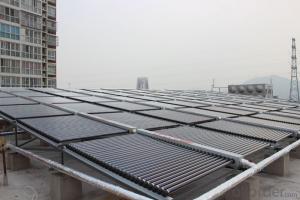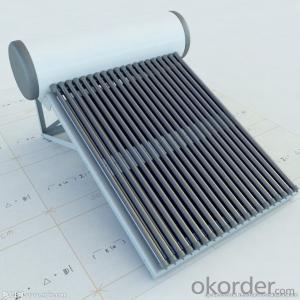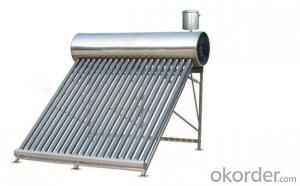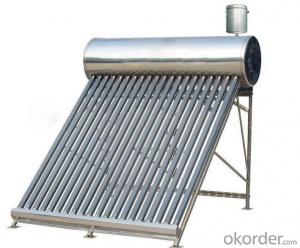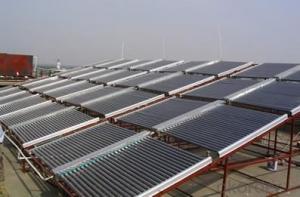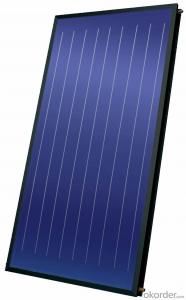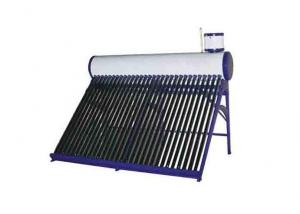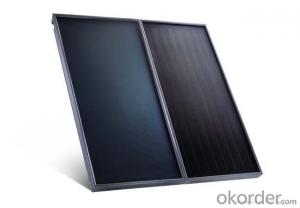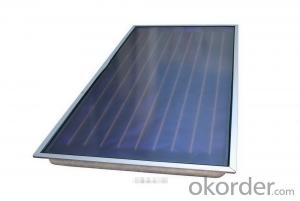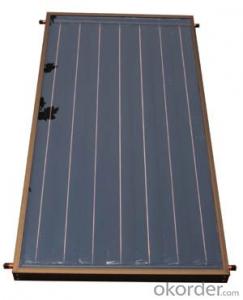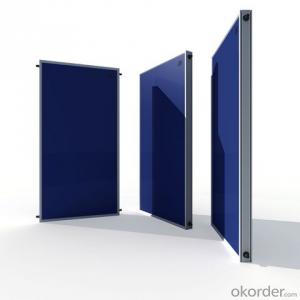Unglazed Solar Collectors Pressurized Heat Pipe Solar Water Heater System
- Loading Port:
- China main port
- Payment Terms:
- TT OR LC
- Min Order Qty:
- 1 set
- Supply Capability:
- 6000 set/month
OKorder Service Pledge
OKorder Financial Service
You Might Also Like
Introduction of Non-Pressure Solar Water Heater:
Non-pressure Solar Heater is one of the most economical solar water heating device with pretty high efficiency at the same time. It consists of hot water storage tank, solar vacuum tubes with mouth plug in storage tank, and bracket supporting tank and tubes.When cold water in evacuated tubes is heated with solar irradiation, as the specific gravities of hot water and cold water are different, hotter water goes upward to storage tank and colder water goes downward to glass tubes. through this continuous circulation, the cold water in storage tank will be gradually heated till sunset.
Specialty:
1. High thermal performance and working temperature: the heat exchanging rate even in winter can up above 55%.
2. Heat collecting efficiency is at least 20% above common solar systems.
3. Work in all day and all season: no matter any corner of the world, this system can work well even -40℃ to avoid the tube freezing problem.
4. Reliability: No water following through the tube, so water scale can not generate and tube cracks could be avoided, the system still can keep working even with some damaged tubes.
5. It can connect with water tap and work automatically with pressure0.6Mpa, bring enjoyable washing experience.
6. Safety: P/T valve would release pressure and temperature to protect tank..
Technical Specification:
1. Outer tank material: SUS304 stainless steel or powder coated color steel
2. Inner tank material: 1.2mm thick SUS304 food grade stainless steel ( Optional material SUS316L)
3. Vacuum tube material: borosilicate glass 3.3; AL-SS-CU absorb coating, with copper heat pipe inside
4. Frame material: 1.2mm thickness stainless steel
5. Insulation material: 55mm thickness polyurethane
6. Suitable for mains pressure water(up to 8 bar/116psi)
7. Easy plug-in installation
8. Install the T/P valve on the pressurized tank
9. Seal material: Stabilized High Temperature Silicon
Outer tank material: SUS304 stainless steel or powder coated color steel
Inner tank material: 1.2mm thick SUS304 food grade stainless steel ( Optional material SUS316L)
Vacuum tube material: borosilicate glass 3.3; AL-SS-CU absorb coating, with copper heat pipe inside
Frame material: 1.2mm thickness stainless steel
Insulation material: 55mm thickness polyurethane
Suitable for mains pressure water(up to 8 bar/116psi)
Easy plug-in installation
Install the T/P valve on the pressurized tank
Seal material: Stabilized High Temperature Silicon
19. Vacuum Tube | 20. Size (mm) | 21. Φ47*1500 / Φ58*1800 / Φ70*2100 | |||||
22. Tube (pcs) | 23. 10 / 12 / 15 / 18 / 20 / 22 / 24 / 30 / 36 / 42 | ||||||
24. Material | 25. Borosilicate 3.3 glass, magnetron spluttering selective coating | ||||||
26. Coating | 27. Single-target AL-N/AL or Three-target AL/N-Cu-SS | ||||||
28. Water Tank | 29. Capacity | 30. 80L ~ 500L for hot water storage tank | |||||
31. Inner tank | 32. Food-grade stainless steel SUS304-2B / SUS316 | ||||||
33. Insulation | 34. High-density polyurethane foam with 70~80 hour heat preservation | ||||||
35. Tank shell | 36. Food-grade stainless steel SUS304-2B | ||||||
37. Bracket | 38. Shaped strong aluminum alloy structure adaptable for flat or slope roof | ||||||
39. Accessories | 40. Anti-aging silicon seals, Dustproof seals, Air-vent cap, Stainless screws | ||||||
41. Auxiliary Devices | 42. Assistant tank, Intelligent controller, Electrical heater, Magnesium anodes | ||||||
43. Tilt Angle | 44. 25 ~ 50° | ||||||
45. Water Output | 46. 45 - 95°C | ||||||
47. Hail Resistance | 48. Φ25mm diameter | ||||||
49. Model Number | 50. Solar Vacuum Tube | 51. Tank 52. Liter | 53. System 54. Liter | 55. Container Loading Qty /sets | |||
56. Size /mm | 57. Qty /pcs | 58. 20GP | 59. 40GP | 60. 40HQ | |||
61. VNS-58SA12-100 | 62. Φ58*1800 | 63. 12 | 64. 100 | 65. 132 | 66. 58 | 67. 119 | 68. 140 |
69. VNS-58SA15-130 | 70. 15 | 71. 130 | 72. 170 | 73. 54 | 74. 108 | 75. 131 | |
76. VNS-58SA18-150 | 77. 18 | 78. 150 | 79. 198 | 80. 43 | 81. 86 | 82. 105 | |
83. VNS-58SA20-170 | 84. 20 | 85. 170 | 86. 223 | 87. 40 | 88. 80 | 89. 97 | |
VNS-58SA24-200 | 24 | 200 | 263 | 35 | 70 | 85 | |
VNS-58SA30-250 | 30 | 250 | 329 | 28 | 56 | 68 | |
VNS-58SA36-300 | 36 | 300 | 395 | 23 | 47 | 57 | |
Product Show
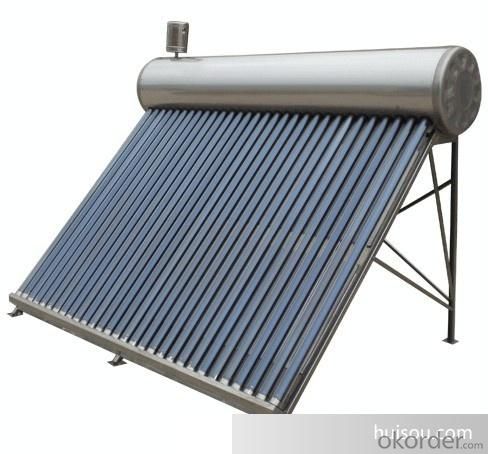
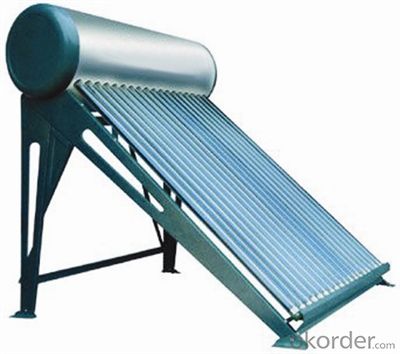
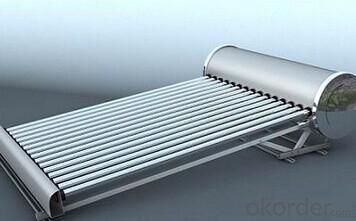
Our Services
1. OEM service
2. Warranty: 5 years
3. Considerable after sale service
Color steel Compact pressure Thermal solar heater
FAQ:
1. What’s the delivery time?
10 days after receiving deposit.
2. How long is the warranty?
5 years for whole system, 1 year for accessory
3. What’s your production capacity?
6000sets/month
4. What’s the MOQ?
1 set.
5. What’s your payment term?
Container: 30% T/T in advance for deposit, 70% T/T before shipment for fist order.
70% T/T after seeing copy of B/L from second order
Sample: 100% T/T in advance
Other choices: L/C at sight.
6. What certifications do you have?
CE, SOLAR KEYMARK, SRCC and etc.
- Q: Can solar collectors be used in combination with air conditioning systems?
- Yes, solar collectors can be used in combination with air conditioning systems. Solar energy can be harnessed to power the air conditioning system, reducing the reliance on traditional energy sources and making it more sustainable and cost-effective. This combination allows for the utilization of renewable energy while maintaining a comfortable indoor environment.
- Q: Do solar collectors require direct sunlight to operate?
- Yes, solar collectors do require direct sunlight to operate efficiently. While they can still generate some energy on cloudy or overcast days, direct sunlight provides the optimal conditions for maximum energy production.
- Q: Can solar collectors be used for heating hotels?
- Yes, solar collectors can be used for heating hotels. Solar thermal systems can be implemented to capture and convert sunlight into heat energy, which can then be used for water heating systems, space heating, or even for heating swimming pools in hotels. This renewable energy source can help hotels reduce their reliance on fossil fuels, lower energy costs, and decrease their carbon footprint.
- Q: Can solar collectors be used in landfill gas-to-energy plants?
- Indeed, landfill gas-to-energy plants can employ solar collectors. These plants harness the methane gas generated through the breakdown of organic waste in landfills to create electricity or heat. As an additional energy source, solar collectors can be seamlessly incorporated into these facilities. They serve the purpose of harnessing solar energy and converting it into electricity, which can then be applied for diverse functions within the plant or fed into the grid. The amalgamation of solar and landfill gas energy sources substantially boosts the efficiency and sustainability of the plant, rendering it more eco-friendly and reducing the need for fossil fuels.
- Q: Is it possible to store excess energy generated by solar collectors?
- Yes, it is possible to store excess energy generated by solar collectors. This can be done using various methods such as battery storage systems, pumped hydro storage, or thermal energy storage. Storing excess energy allows for its use during periods of low or no sunlight, providing a reliable and continuous power supply.
- Q: What is the temperature range of a solar collector?
- The temperature range of a solar collector can vary depending on the type and design, but typically, it can reach temperatures ranging from 70 degrees Fahrenheit (21 degrees Celsius) to 200 degrees Fahrenheit (93 degrees Celsius).
- Q: How do solar collectors perform in extreme temperatures?
- Solar collectors are designed to withstand extreme temperatures and continue to perform efficiently. In hotter conditions, they may experience a slight decrease in efficiency due to increased thermal losses, but overall, their performance remains reliable. In colder climates, solar collectors also function well as they are designed to absorb and convert sunlight into heat energy, regardless of the temperature.
- Q: How do solar collectors compare to traditional heating methods in terms of efficiency?
- Solar collectors outperform traditional heating methods when it comes to converting energy. Fossil fuel-based systems, for example, rely on burning fuels to produce heat, resulting in energy loss through combustion byproducts. In contrast, solar collectors directly convert sunlight into heat energy, minimizing energy loss and maximizing efficiency. Not only are solar collectors more efficient in terms of energy conversion, but they can also be more cost-effective. Unlike traditional heating methods that require ongoing fuel purchases, solar energy is readily available and free, leading to reduced long-term costs. Additionally, solar collectors demand less maintenance compared to traditional heating systems, resulting in lower operational costs. It is important to consider that the effectiveness of solar collectors can be influenced by various factors, including the collector's size, orientation, insulation level, and climate conditions. Nevertheless, advancements in solar technology have greatly enhanced the efficiency of solar collectors over time, making them an increasingly attractive and effective alternative to traditional heating methods.
- Q: How do solar collectors perform in polluted areas?
- Solar collectors may not perform as efficiently in polluted areas due to the presence of air pollutants, such as smog and dust, which can block sunlight and reduce the amount of solar radiation reaching the collectors. This can result in a decrease in the overall energy output of the solar collectors. Regular cleaning and maintenance of the collectors may help mitigate the effects of pollution and maintain optimal performance.
- Q: Are solar collectors environmentally friendly?
- Yes, solar collectors are environmentally friendly as they harness the energy from the sun, a renewable source, to generate electricity or heat without emitting harmful greenhouse gases or pollutants. They help reduce dependence on fossil fuels and contribute to mitigating climate change.
Send your message to us
Unglazed Solar Collectors Pressurized Heat Pipe Solar Water Heater System
- Loading Port:
- China main port
- Payment Terms:
- TT OR LC
- Min Order Qty:
- 1 set
- Supply Capability:
- 6000 set/month
OKorder Service Pledge
OKorder Financial Service
Similar products
Hot products
Hot Searches
Related keywords
